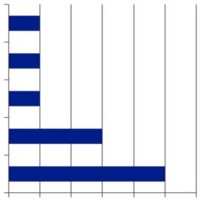Bacteriological Profile of Pancreatic Juice in Patients with Chronic Pancreatitis
DOI:
https://doi.org/10.6092/1590-8577/2256Keywords:
Gastroenterology, Pancreas, Pancreatic Juice, Pancreatitis, ChronicAbstract
Context Information regarding the association of bacteria in the pancreatic fluid in patients with chronic pancreatitis is limited. Objective This study was designed to analyze the prevalence of bacteria in pancreatic juice in patients with chronic pancreatitis and the association of positive pancreatic fluid culture with pre-operative and post-operative parameters. Methods All patients with chronic pancreatitis who underwent operation from November 2011 to October 2013 were prospectively included in the study. Intra-operatively pancreatic duct fluid was collected and sent for culture sensitivity in all patients. The bacteriology of the fluid was analyzed and was correlated with preoperative, intraoperative and postoperative parameters. Results A total of 26 patients were analyzed. Two patients underwent endoscopic retrograde cholangio-pancreatography (ERCP) preoperatively. Bacteria was present in pancreatic duct fluid in 11 (42%) patients. Both patients who underwent ERCP had positive cultures. Most common organism observed was Escherichia coli (6/11, 55%) followed by Klebsiella pneumonia (3/11, 27%). Five patients with positive culture developed wound infection. Bacteria isolated from the wound were similar to pancreatic fluid. Conclusion Bacteria is commonly present in the pancreatic juice in patients with chronic pancreatitis and its presence may have an effect on the post-operative infections following operations. Based on the pancreatic fluid culture results appropriate antibiotic can be given to the patients who will develop septic complications following surgery. Role of bacteria in the pathogenesis of the chronic calcific pancreatitis needs to be investigated in future studies.
Image: Bacteria in pancreatic fluid in patients with chronic pancreatitis.
Downloads
References
Yelamali A, Mansard M, Rao P, Dama R, Rebela P, Rao GV, Reddy N. Bacteriology of pancreatic fluid in chronic calcific pancreatitis. J Gastroenterol Hepatol. 2011; 26 (Suppl. 5): 23.
Povoski SP, Karpeh MS Jr, Conlon KC, et al. Association of preoperative biliary drainage with postoperative outcome following pancreaticoduodenectomy. Ann Surg. 1999; 230: 131-142. [PMID:10450725]
Rerknimitr R, Fogel EL, Kalayci C, et al. Microbiology of bile in patients with cholangitis or cholestasis with and without plastic biliary endoprosthesis. Gastrointest Endosc. 2002; 56: 885-889. [PMID:12447303]
Gregg JA. Detection of bacterial infection of the pancreatic ducts in patients with pancreatitis and pancreatic cancer during endoscopic cannulation of the pancreatic duct. Gastroenterology. 1977; 73: 1005-1007. [PMID:332575]
Kountouras J, Zavos C, Chatzopoulos D. A concept on the role of Helicobacter pylori infection in autoimmune pancreatitis J Cell Mol Med. 2005; 9: 196-207.
Hassan MM, Li D, El-Deeb AS, et al. Association between hepatitis B virus and pancreatic cancer. J Clin Oncol. 2008; 26: 4557-62. [PMID:18824707]
Katakura Y, Yotsuyanagi H, Hashizume K, et al. Pancreatic involvement in chronic viral hepatitis. World J Gastroenterol. 2005; 11: 3508-3513. [PMID:15962364]
Behrman SW, Fowler ES. Pathophysiology of chronic pancreatitis. Surg Clin North Am. 2007; 87: 1309-1324.
Sarles H. Etiopathogenesis and definition of chronic pancreatitis. Dig Dis Sci. 1986; 31: 91S-107S. [PMID:3525051]
Li JS, Zhang ZD, Tang Y, Jiang R. Retrospective analysis of 88 patients with pancreatic duct stone. Hepatobiliary Pancreat Dis Int. 2007; 6: 208-212. [PMID:17374584]
Shoda J, Tanaka N, Osuga T. Hepatolithiasis--epidemiology and pathogenesis update. Front Biosci. 2003; 8: e398-409. [PMID:12700089]
Leung JW, Liu YL, Leung PS, et al. Expression of bacterial beta-glucuronidase in human bile: an in vitro study. Gastrointest Endosc. 2001; 54: 346-350. [PMID:11522976]
Mori T. Report from Working Group for Etiology and Prognosis of Intrahepatic Stones. Annual Reports of the Japanese Ministry of Health and Welfare [in Japanese], Tokyo: Japanese Government;2008: 21-23.


